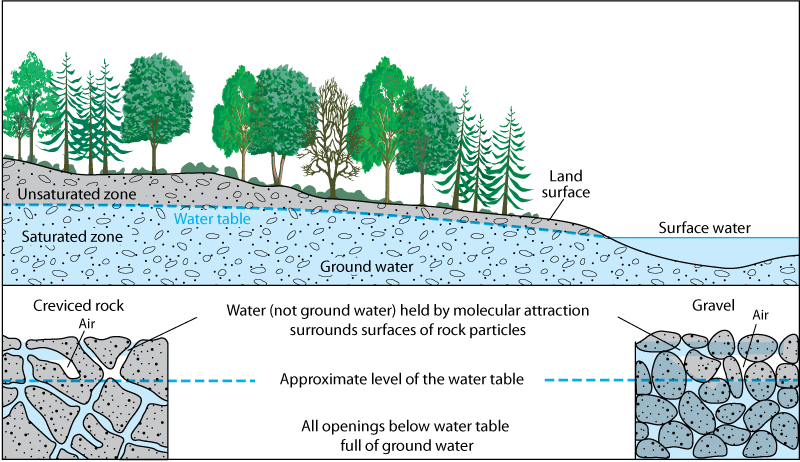Water Sources
On This Page
Overview
Community water systems obtain water from two sources: surface water and ground water. People use surface and ground water every day for a variety of purposes, including drinking, cooking, and basic hygiene, in addition to recreational, agricultural, and industrial activities. According to the United States Environmental Protection Agency (EPA), the majority of public water systems (91%) are supplied by ground water; however, more persons (68%) are supplied year-round by community water systems that use surface water (1). This is because large, well-populated metropolitan areas tend to rely on surface water supplies, whereas small, rural areas tend to rely on ground water.

Figure courtesy of USGS
Surface Water
Surface water is water that collects on the ground or in a stream, river, lake, reservoir, or ocean. Surface water is constantly replenished through precipitation, and lost through evaporation and seepage into ground water supplies. According to the EPA, 68% of community water system users received their water from a surface water source, such as a lake (1).
United States Geological Survey (USGS) resources on surface water:
- Surface Water Topics
- USGS Water Watch (map of real-time stream flow and historical trends for your area)
Ground Water
Ground water, which is obtained by drilling wells, is water located below the ground surface in pores and spaces in the rock, and is used by approximately 78% of community water systems in the United States, supplying drinking water to 32% of community water system users (1). EPA also estimates that approximately 15% of the U.S. population relies on private ground water wells (2).
USGS resources on ground water:
Source Water Protection
Even though most community drinking water (especially from surface water sources) is treated before entering the home, the cost of this treatment and the risks to public health can be reduced by protecting source water from contamination. We all live in a watershed, which is an area that drains to a common waterway such as a stream, lake, wetland, or ocean. EPA and many other organizations collaborate with communities to work toward protecting watersheds.
EPA Information on specific watersheds:
References
- Environmental Protection Agency. Factoids: drinking water and ground water statistics for 2007. March 2008, April 2008. Available at http://nepis.epa.gov/Exe/ZyPDF.cgi/P100N2VG.PDF?Dockey=P100N2VG.PDF.
- Environmental Protection Agency. Private drinking water wells. Available at http://water.epa.gov/drink/info/well/index.cfm.
- Page last reviewed: April 10, 2009
- Page last updated: April 10, 2009
- Content source:


 ShareCompartir
ShareCompartir